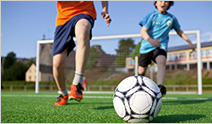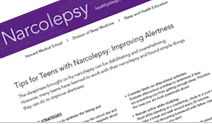The Takeaway
- Students with narcolepsy can perform well in school. Teachers and school staff can help parents identify signs of narcolepsy in a child, and, if the child is diagnosed, help work out a plan to provide academic support.
- Students can improve alertness by scheduling naps, keeping a regular sleep schedule, and working with their doctor to optimize medications.
Narcolepsy usually begins just before or during the teen years and can impact a child’s school performance, teachers’ perceptions of the child, and the child's interactions with peers. School can be frustrating when narcolepsy makes it hard to stay alert in class and focus during tests.
Teens with narcolepsy often have to work hard to establish and maintain a schedule that works well for them during their high school years. Such planning requires self-discipline. It also requires understanding from those in his or her life.

Despite the challenges, academic success—as well as good social and emotional development in school—is achievable once appropriate strategies are identified and implemented. In fact, students with narcolepsy obtain college degrees just as often as the general population.1
Identifying issues
As narcolepsy typically develops during the teen years, it often impacts school and after-school activities. Some sleepiness is common in teens, so it is important to be on the lookout for additional clues that might suggest narcolepsy.
The first indicators of trouble related to narcolepsy can be difficulty completing homework or even falling grades. These may show that a student is experiencing excessive daytime sleepiness that makes it difficult to sustain attention for long periods.
Teachers often are in the best position to rate a child’s alertness and can help parents get a better understanding of their child’s school experience. However, teachers may notice a child dozing off but assume the child is uninterested or simply needs more sleep. Likewise, many children may not fully appreciate how their sleepiness affects their school performance. Therefore, it is important for parents to maintain an active dialogue with their child and their child’s teachers, school nurses, and others to assess the extent of daytime sleepiness. This dialogue should continue both before and after diagnosis.
Working with schools
Once narcolepsy has been medically diagnosed, close communication between parents, teachers, school administrators, and others at the school is key to helping a child with narcolepsy succeed. Narcolepsy symptoms and their severity differ among individuals, so any special plans must be tailored to each child’s specific needs.
Narcolepsy education Lisa Rezza describes school support resources available to students and their families.
As most people are unfamiliar with or have misconceptions about narcolepsy, teachers and others may benefit from learning more about the disorder. This is especially important if symptoms are still problematic even after medications are optimized and the child is getting enough sleep. Download Understanding Narcolepsy in School Settings (PDF) for more information on narcolepsy and how it may impact academic success, and share it, and this website, with school staff.
A note from a child’s doctor describing how narcolepsy affects the child’s academic performance is often helpful. In addition, the doctor can specify how medications should be taken during school, and, if needed, may recommend that a student be permitted to nap during school in the nurse’s office or elsewhere.
Check in periodically with the school nurse to ensure that his or her office has the most up-to-date list of any medications that should be taken during school hours.

Ask the school nurse and others in contact with the child if they can provide updates when they notice changes in the child's behavior. Passing this information along to the child's doctor can help the provider refine treatment plans.
Special education plans
Sometimes it is helpful to develop a special education plan to meet the needs of a student with narcolepsy.
For more information on these two types of plans, see the National Center for Learning Disabilities “Section 504 and IEP Comparison Chart web page.
- Types of plans. There are two main types of special education plans: Section 504 plans and Individualized Education Program plans.
- Section 504 plans are designed to protect the rights of individuals with disabilities in programs such as public schools that receive federal funding from the US Department of Education. These plans are managed under a school’s general education program.
- In contrast, Individualized Education Program (IEP) plans are generally geared toward specialized education programs and placements outside of the regular classroom for students who are eligible under the Individuals with Disabilities Education Act.
- Evaluation. Each elementary and secondary school student with narcolepsy must be individually evaluated because simply having narcolepsy or another disorder does not automatically qualify a student for accommodations. Specialized evaluations, known as psycho-educational and neuropsychological evaluations, are often useful in identifying cognitive strengths and weaknesses in children with narcolepsy.
- Accommodations. If a student is identified as being eligible for aids or services, the next step is to determine which services will be most appropriate. Accommodations should be tailored to each student’s needs. Examples of helpful accommodations include extra time or a short break during tests, help with taking notes, designated nap space, and recording devices such as smart pens that synchronize spoken words with notes. Having teachers share class notes or slides, or having audio versions of textbooks available to provide additional support while reading, can also be helpful.
Improving alertness
The sleepiness brought on by narcolepsy can be debilitating and overwhelming. However, many children have learned to work with their narcolepsy and have found simple things they can do to improve alertness at school.

Here are some strategies:
- Work with a doctor to optimize the timing and doses of medications. This can help improve alertness across the school day and while studying later. Talk with your doctor regularly about how medications are working.
- Stay active during classes. Some teens find it useful to sit in the back of the class so they can stand up and walk around or get a drink. Others may find that being in the front of the room works best. Staying engaged in the material and asking questions can also help sustain alertness, as can doing something as simple as chewing sugar-free gum.
- Take a 15- to 20-minute nap during the school day.School administrators may be able to provide a place to do so, such as the nurse’s office. Some people may tend toward longer naps, but it is often best to keep the nap short as longer naps can make it harder to sleep well at night. Experiment until you find what works best for you.
- Take a brief nap after school. A brief nap before or between after-school activities can help sustain alertness later in the day.
- Consider limits on after-school activities. Evaluate after-school activities to determine if they are preventing you from getting enough sleep. Prioritize the ones you are most passionate about.
- Remain active while studying. Read while standing at a countertop, study in a cool room, or take a break and walk around every 20 minutes. Studying and discussing homework with fellow classmates can also help keep you alert.
- Take an exercise break. Exercise can improve alertness for 15–30 minutes afterwards.
- Keep a regular sleep schedule. Going to bed and waking at the same time each day, including weekends, can help you fall asleep and awaken more easily. Although challenging, this self-discipline is especially important in the often busy and sometimes chaotic years of high school and college.
- Get enough sleep at night. On average, children ages 5–12 need 10–11 hours of sleep, and teens ages 13–18 need 8.5–9.5 hours of sleep. Everyone feels sleepy if they don't get enough sleep, but this can hit teens with narcolepsy especially hard.
Patient Audrey Cross comments about the benefits of taking a nap at school

Download a printable version of Tips for Teens with Narcolepsy: Improving Alertness (PDF) to hand out to teachers, nurses, and school administrators to help them better understand what can be done to increase your alertness.